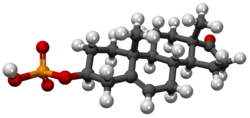ER Tooltip Estrogen receptor
Agonists Steroidal: 2-Hydroxyestradiol 2-Hydroxyestrone 3-Methyl-19-methyleneandrosta-3,5-dien-17β-ol 3α-Androstanediol 3α,5α-Dihydrolevonorgestrel 3β,5α-Dihydrolevonorgestrel 3α-Hydroxytibolone 3β-Hydroxytibolone 3β-Androstanediol 4-Androstenediol 4-Androstenedione 4-Fluoroestradiol 4-Hydroxyestradiol 4-Hydroxyestrone 4-Methoxyestradiol 4-Methoxyestrone 5-Androstenediol 7-Oxo-DHEA 7α-Hydroxy-DHEA 7α-Methylestradiol 7β-Hydroxyepiandrosterone 8,9-Dehydroestradiol 8,9-Dehydroestrone 8β-VE2 10β,17β-Dihydroxyestra-1,4-dien-3-one (DHED) 11β-Chloromethylestradiol 11β-Methoxyestradiol 15α-Hydroxyestradiol 16-Ketoestradiol 16-Ketoestrone 16α-Fluoroestradiol 16α-Hydroxy-DHEA 16α-Hydroxyestrone 16α-Iodoestradiol 16α-LE2 16β-Hydroxyestrone 16β,17α-Epiestriol (16β-hydroxy-17α-estradiol) 17α-Estradiol (alfatradiol ) 17α-Dihydroequilenin 17α-Dihydroequilin 17α-Epiestriol (16α-hydroxy-17α-estradiol) 17α-Ethynyl-3α-androstanediol 17α-Ethynyl-3β-androstanediol 17β-Dihydroequilenin 17β-Dihydroequilin 17β-Methyl-17α-dihydroequilenin Abiraterone Abiraterone acetate Alestramustine Almestrone Anabolic steroids (e.g., testosterone and esters , methyltestosterone , metandienone (methandrostenolone) , nandrolone and esters , many others; via estrogenic metabolites) Atrimustine Bolandiol Bolandiol dipropionate Butolame Clomestrone Cloxestradiol Conjugated estriol Conjugated estrogens Cyclodiol Cyclotriol DHEA DHEA-S ent -Estradiol Epiestriol (16β-epiestriol, 16β-hydroxy-17β-estradiol) Epimestrol Equilenin Equilin ERA-63 (ORG-37663) Esterified estrogens Estetrol Estradiol Estramustine Estramustine phosphate Estrapronicate Estrazinol Estriol Estrofurate Estrogenic substances Estromustine Estrone Etamestrol (eptamestrol) Ethinylandrostenediol Ethinylestradiol Ethinylestriol Ethylestradiol Etynodiol Etynodiol diacetate Hexolame Hippulin Hydroxyestrone diacetate Lynestrenol Lynestrenol phenylpropionate Mestranol Methylestradiol Moxestrol Mytatrienediol Nilestriol Norethisterone Noretynodrel Orestrate Pentolame Prodiame Prolame Promestriene RU-16117 Quinestradol Quinestrol Tibolone Xenoestrogens: Anise -related (e.g., anethole , anol , dianethole , dianol , photoanethole ) Chalconoids (e.g., isoliquiritigenin , phloretin , phlorizin (phloridzin) , wedelolactone ) Coumestans (e.g., coumestrol , psoralidin ) Flavonoids (incl. 7,8-DHF , 8-prenylnaringenin , apigenin , baicalein , baicalin , biochanin A , calycosin , catechin , daidzein , daidzin , ECG , EGCG , epicatechin , equol , formononetin , glabrene , glabridin , genistein , genistin , glycitein , kaempferol , liquiritigenin , mirificin , myricetin , naringenin , penduletin , pinocembrin , prunetin , puerarin , quercetin , tectoridin , tectorigenin ) Lavender oil Lignans (e.g., enterodiol , enterolactone , nyasol (cis -hinokiresinol) ) Metalloestrogens (e.g., cadmium ) Pesticides (e.g., alternariol , dieldrin , endosulfan , fenarimol , HPTE , methiocarb , methoxychlor , triclocarban , triclosan ) Phytosteroids (e.g., digitoxin (digitalis ), diosgenin , guggulsterone ) Phytosterols (e.g., β-sitosterol , campesterol , stigmasterol ) Resorcylic acid lactones (e.g., zearalanone , α-zearalenol , β-zearalenol , zearalenone , zeranol (α-zearalanol) , taleranol (teranol, β-zearalanol) ) Steroid -like (e.g., deoxymiroestrol , miroestrol ) Stilbenoids (e.g., resveratrol , rhaponticin ) Synthetic xenoestrogens (e.g., alkylphenols , bisphenols (e.g., BPA , BPF , BPS ), DDT , parabens , PBBs , PHBA , phthalates , PCBs ) Others (e.g., agnuside , rotundifuran ) MixedSERMs Tooltip Selective estrogen receptor modulators ) Antagonists Coregulator-binding modulators: ERX-11
GPER Tooltip G protein-coupled estrogen receptor
Agonists Antagonists Unknown
Ionotropic
GABAA Tooltip γ-Aminobutyric acid A receptor Positive modulators (abridged; see here for a full list): α-EMTBL Alcohols (e.g., drinking alcohol , 2M2B ) Anabolic steroids Avermectins (e.g., ivermectin ) Barbiturates (e.g., phenobarbital ) Benzodiazepines (e.g., diazepam ) Bromide compounds (e.g., potassium bromide ) Carbamates (e.g., meprobamate ) Carbamazepine Chloralose Chlormezanone Clomethiazole Dihydroergolines (e.g., ergoloid (dihydroergotoxine) ) Etazepine Etifoxine Fenamates (e.g., mefenamic acid ) Flavonoids (e.g., apigenin , hispidulin ) Fluoxetine Flupirtine Imidazoles (e.g., etomidate ) Kava constituents (e.g., kavain ) Lanthanum Loreclezole Monastrol Neuroactive steroids (e.g., allopregnanolone , cholesterol , THDOC ) Niacin Niacinamide Nonbenzodiazepines (e.g., β-carbolines (e.g., abecarnil ), cyclopyrrolones (e.g., zopiclone ), imidazopyridines (e.g., zolpidem ), pyrazolopyrimidines (e.g., zaleplon )) Norfluoxetine Petrichloral Phenols (e.g., propofol ) Phenytoin Piperidinediones (e.g., glutethimide ) Propanidid Pyrazolopyridines (e.g., etazolate ) Quinazolinones (e.g., methaqualone ) Retigabine (ezogabine) ROD-188 Skullcap constituents (e.g., baicalin ) Stiripentol Sulfonylalkanes (e.g., sulfonmethane (sulfonal) ) Topiramate Valerian constituents (e.g., valerenic acid ) Volatiles /gases (e.g., chloral hydrate , chloroform , diethyl ether , paraldehyde , sevoflurane ) Negative modulators: 1,3M1B 3M2B 11-Ketoprogesterone 17-Phenylandrostenol α3IA α5IA (LS-193,268) β-CCB β-CCE β-CCM β-CCP β-EMGBL Anabolic steroids Amiloride Anisatin β-Lactams (e.g., penicillins , cephalosporins , carbapenems ) Basmisanil Bemegride Bicyclic phosphates (TBPS , TBPO , IPTBO ) BIDN Bilobalide Bupropion CHEB Chlorophenylsilatrane Cicutoxin Cloflubicyne Cyclothiazide DHEA DHEA-S Dieldrin (+)-DMBB DMCM DMPC EBOB Etbicyphat FG-7142 (ZK-31906) Fiproles (e.g., fipronil ) Flavonoids (e.g., amentoflavone , oroxylin A ) Flumazenil Fluoroquinolones (e.g., ciprofloxacin ) Flurothyl Furosemide Golexanolone Iomazenil (123 I) IPTBO Isopregnanolone (sepranolone) L-655,708 Laudanosine Lindane MaxiPost Morphine Morphine-3-glucuronide MRK-016 Naloxone Naltrexone Nicardipine Nonsteroidal antiandrogens (e.g., apalutamide , bicalutamide , enzalutamide , flutamide , nilutamide ) Oenanthotoxin Pentylenetetrazol (pentetrazol) Phenylsilatrane Picrotoxin (i.e., picrotin , picrotoxinin and dihydropicrotoxinin ) Pregnenolone sulfate Propybicyphat PWZ-029 Radequinil Ro 15-4513 Ro 19-4603 RO4882224 RO4938581 Sarmazenil SCS Suritozole TB-21007 TBOB TBPS TCS-1105 Terbequinil TETS Thujone U-93631 Zinc ZK-93426 GABAA -ρ Tooltip γ-Aminobutyric acid A-rho receptor
Metabotropic
GABAB Tooltip γ-Aminobutyric acid B receptor
AMPAR Tooltip α-Amino-3-hydroxy-5-methyl-4-isoxazolepropionic acid receptor KAR Tooltip Kainate receptor NMDAR Tooltip N-Methyl-D-aspartate receptor
Group I
mGluR1 Tooltip Metabotropic glutamate receptor 1 mGluR5 Tooltip Metabotropic glutamate receptor 5
Group II
mGluR2 Tooltip Metabotropic glutamate receptor 2 mGluR3 Tooltip Metabotropic glutamate receptor 3
Group III
mGluR4 Tooltip Metabotropic glutamate receptor 4 mGluR6 Tooltip Metabotropic glutamate receptor 6 mGluR7 Tooltip Metabotropic glutamate receptor 7 mGluR8 Tooltip Metabotropic glutamate receptor 8
Angiopoietin CNTF EGF (ErbB)
FGF
FGFR1 FGFR2 Agonists: Ersofermin FGF (1 , 2 (bFGF) , 3 , 4 , 5 , 6 , 7 (KGF ), 8 , 9 , 10 (KGF2) , 17 , 18 , 22 ) Palifermin Repifermin Selpercatinib Sprifermin Trafermin FGFR3 FGFR4 Unsorted
HGF (c-Met) IGF
LNGF (p75NTR ) PDGF RET (GFL)
SCF (c-Kit) TGFβ Trk
TrkA Negative allosteric modulators: VM-902A TrkB Agonists: 3,7-DHF 3,7,8,2'-THF 4'-DMA-7,8-DHF 7,3'-DHF 7,8-DHF 7,8,2'-THF 7,8,3'-THF Amitriptyline BDNF BNN-20 Deoxygedunin Deprenyl Diosmetin DMAQ-B1 HIOC LM22A-4 N-Acetylserotonin NT-3 NT-4 Norwogonin (5,7,8-THF) R7 R13 TDP6 TrkC
VEGF Others Additional growth factors: Adrenomedullin Colony-stimulating factors (see here instead) Connective tissue growth factor (CTGF) Ephrins (A1 , A2 , A3 , A4 , A5 , B1 , B2 , B3 ) Erythropoietin (see here instead) Glucose-6-phosphate isomerase (GPI; PGI, PHI, AMF) Glia maturation factor (GMF) Hepatoma-derived growth factor (HDGF) Interleukins /T-cell growth factors (see here instead) Leukemia inhibitory factor (LIF) Macrophage-stimulating protein (MSP; HLP, HGFLP) Midkine (NEGF2) Migration-stimulating factor (MSF; PRG4) Oncomodulin Pituitary adenylate cyclase-activating peptide (PACAP) Pleiotrophin Renalase Thrombopoietin (see here instead) Wnt signaling proteins Additional growth factor receptor modulators: Cerebrolysin (neurotrophin mixture)
CAR Tooltip Constitutive androstane receptor PXR Tooltip Pregnane X receptor

